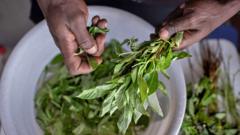This trend is bolstered by growing health consciousness among Kenyans who recognize the superior nutritional profiles of these indigenous greens. With the production of local leafy vegetables doubling over the past decade to 300,000 tonnes, they are increasingly appreciated for their health benefits, which include detoxification and weight loss. Horticulture professor Mary Abukutsa-Onyango champions the nutritional advantages of these vegetables, highlighting higher levels of essential vitamins and minerals compared to more common imports.
A notable project initiated in 2007, supported by UNESCO, aims to catalog traditional foods in Kenya, leading to an inventory of 850 indigenous plants. While native crops are being celebrated, challenges remain, such as government regulations restricting seed exchanges. Farmers like Francis Ngiri advocate for organic farming of indigenous varieties, even as they face legal hurdles.
As the market for indigenous greens flourishes, vendors at local markets, like Priscilla Njeri, report a growing demand, attributing it to increased awareness fueled by media promotion. This cultural revival not only reflects changing attitudes towards nutrition but also highlights a crucial step toward preserving biodiversity and traditional ecological knowledge for future generations.
In this dynamic landscape, the culinary shift towards indigenous leafy vegetables not only nourishes bodies but also revitalizes cultural heritage, presenting a compelling story of resilience and adaptation among Kenya's agricultural communities.
A notable project initiated in 2007, supported by UNESCO, aims to catalog traditional foods in Kenya, leading to an inventory of 850 indigenous plants. While native crops are being celebrated, challenges remain, such as government regulations restricting seed exchanges. Farmers like Francis Ngiri advocate for organic farming of indigenous varieties, even as they face legal hurdles.
As the market for indigenous greens flourishes, vendors at local markets, like Priscilla Njeri, report a growing demand, attributing it to increased awareness fueled by media promotion. This cultural revival not only reflects changing attitudes towards nutrition but also highlights a crucial step toward preserving biodiversity and traditional ecological knowledge for future generations.
In this dynamic landscape, the culinary shift towards indigenous leafy vegetables not only nourishes bodies but also revitalizes cultural heritage, presenting a compelling story of resilience and adaptation among Kenya's agricultural communities.


















